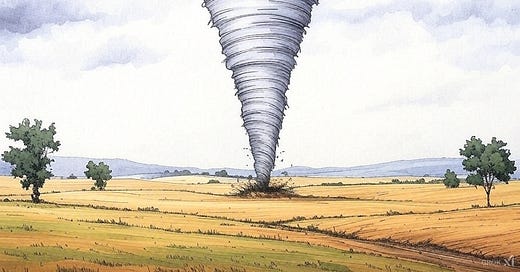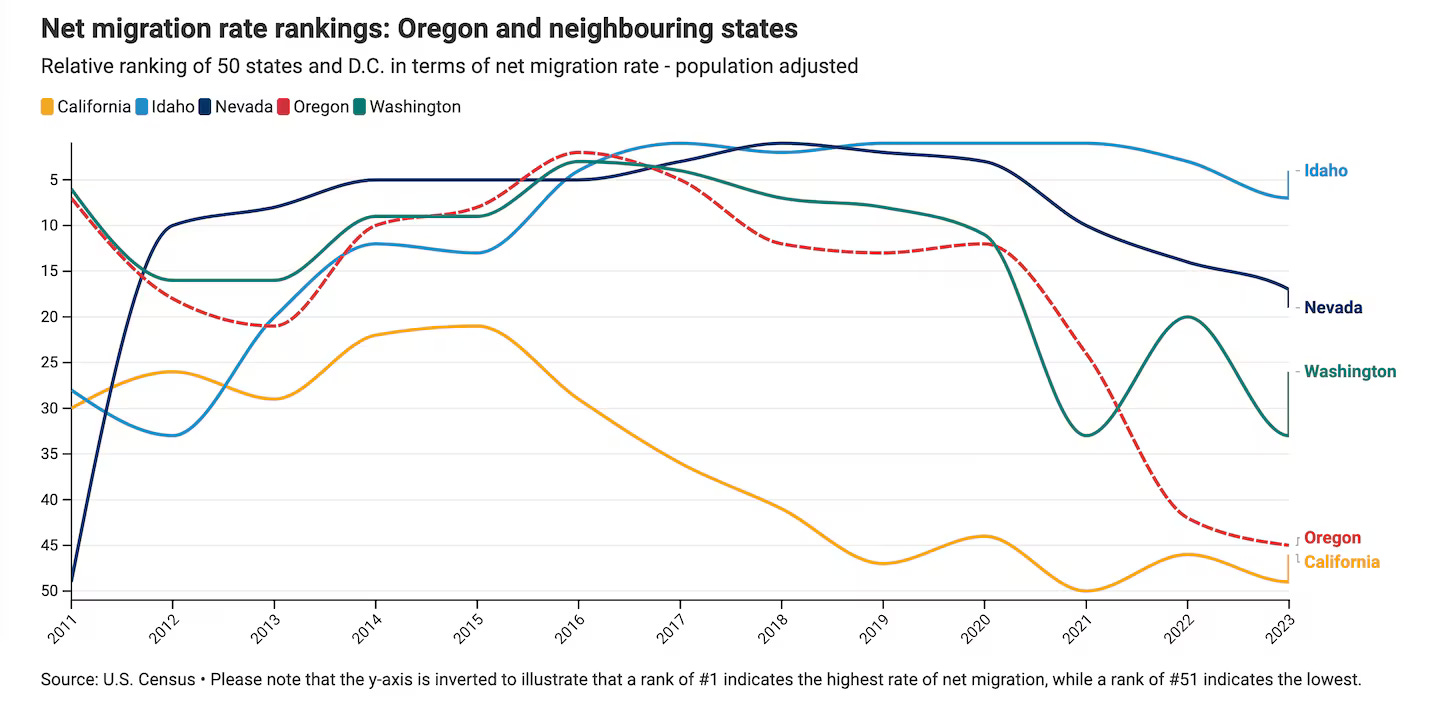Tornadoes in the 45th Parallel
It's not why Oregon has lost its shine as a destination for interstate migrants
It’s not unusual during the Willamette Valley winter to have multiple days of one wave of rain barrel through after the other in fairly short succession. It’s wet here. There is no camouflaging that with talk of The Great Northwest, declarations of “it’s just so green here”, or with platitudes about it being a foodie capital. We are usually wet here.
So, it was unusual yesterday, as yet another band of heavy rain and wind moved through the Valley, that all the televisions and radios stopped simultaneously to provide a Tornado Warning for the area from Salem to Portland.
The tornado warning only lasted for about a half hour as a particularly fast rotating storm cell came and went. The unusual warning reminded me that, save for the seemingly constant rain, the weather in this neck of the woods is pretty darned benign—particularly for the 45th parallel.
Being curious and a California boy whose closest run-in with tornado conditions—let alone a real tornado—is the fast swirling water from my bathtub, I immediately got up from my desk upon hearing the tornado warning, went outside, looked up, and scanned the grey for anything that might resemble funnels. This is what you’re supposed to do, right?
I saw nothing. I just got wet.
The 45th parallel is a pretty interesting place. It runs through the Willamette Valley, Bordeaux, the Rhone Valley, and Piedmont in Italy, all regions of great wine production and very few tornados. However, that parallel also runs through some pretty inhospitable places in the winter, like northern Wyoming, South Dakota, Minnesota, Northern Michigan, and Maine. The relatively benign weather here has always been part of the area’s allure.
The Willamette Valley and Oregon in general has for many years been a very popular place to move to. It was less expensive than other West Coast locations. Its reputation for beauty preceded it. There was a small big city in the way of Portland. So, for many years Oregon saw high migration—people moving here from outside the state. In 2016, in fact, Oregon was the #2 most popular state to move to. And this helped fuel the rise of the Oregon wine industry.
By 2023, however, Oregon fell to 45th on the list of most popular states to move to. In 2023 more people actually moved away from Oregon than moved to Oregon, and it wasn’t due to the tornado warnings. The culprit is a high cost of living due in part to higher taxes and housing shortages according to a 2024 study of state demographics.
It also turns out according to the same study that Oregon has one of the lowest fertility rates in the country. The second lowest in the country, in fact, with only Vermonters producing fewer children than Oregonians. Again, it’s a matter of a relatively higher cost of living with those in prime child-bearing age choosing to live where it is more affordable. The median age of Oregonians is relatively high at 39.9 years. Kathy and I are older than this, but to our credit, we did haul a youngster with us to Oregon when we moved here. So, we are kinda off the hook. Kinda.
The other thing to understand about the Willamette Valley, besides the lack of tornadoes and children and the proliferation of good truffles, is that it is part of the Cascadian West, as opposed to the Cascadian East. The Cascade mountains that run north to south and divide both Oregon and Washington is in fact a political divide as much as a geographic divide. West of the Cascades (the Willamette Valley) is a liberal and progressive region and it is where the largest portion of the population resides. East of the Cascades you have very conservative politics and much lower population density. It’s really two different cultures.
So, let’s do the math on the Willamette Valley: Beautiful, near the ocean, near the mountains, great wine, lots of mushrooms and truffles, proximity to a small big city in Portland, relatively liberal in its politics, a gateway to the east, very few tornadoes. On the other hand, higher cost of living and fewer housing choices.
Before Kathy, Henry, and I moved here in February of 2019, we were warned of two things: Oregonians don’t like Californians moving in so watch your back and the weather in the winter is relentlessly wet so prepare yourself. No one EVER warned of tornadoes.
The unwelcoming disposition toward Californians never emerged, probably because the Californians had already taken over the state by that time. California had always been one of the primary sources of interstate migrants before migration to Oregon took a nose dive so we Californians had pretty much already filled in the gaps from Portland to Eugene. And despite this winter being relatively benign and moderate compared to other Oregon winters, the warnings of wetness were on the mark.
The tornado warning yesterday turned out to be nothing more than a warning. A twister never emerged from the rotating cell that moved from Salem up through Portland. We just got heavy rain and high winds.
All of this is to say that the Oregon version of the 45th parallel remains a pretty lovely place to be. We have access to great wines. We can hop to the beach or the mountains in about an hour or two. If you have young kids there are fewer birthday parties to go to since we don’t really have kids up here. And, of course, the tornadoes are few and far between.






I was in Willamette Valley in 1993, and one afternoon visited Domaine Drouhin. Perfect day, great wines, breathtaking view and so forth. I was tasting with the managing director at the time. We were sitting outside. I gestured out toward the east and said, "What's out there?" He said, "We don't go out there. That's the realm of motorcycles and shotguns."
As a Willamite you seem to have a few minuses but a lot of pluses. Cheers from this Aussie.